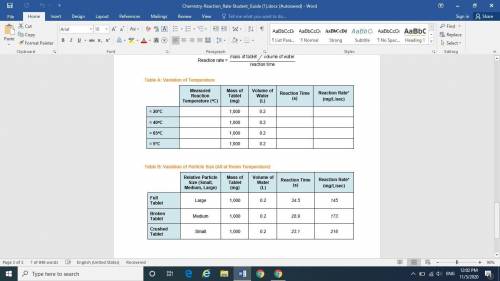Lab Reaction Rate :
Variation of Temperature
Step 2: Measure the Reaction Rate at ≈ 20°C (Roo...

Chemistry, 05.11.2020 20:30 CloutLEVEL
Lab Reaction Rate :
Variation of Temperature
Step 2: Measure the Reaction Rate at ≈ 20°C (Room Temperature)
Step 3: Measure the Reaction Rate at ≈ 40°C
Step 4: Repeat Step 2, heating the water to Measure the Reaction Rate at ≈ 65°C
Step 5: Measure the Reaction Rate at ≈ 5°C
Variation of Particle Size
Step 6: Measure the Reaction Rate for a Full Tablet
Step 7: Measure the Reaction Rate for a Partially Broken Tablet
Step 8: Measure the Reaction Rate for a Crushed Tablet




Answers: 2


Another question on Chemistry

Chemistry, 21.06.2019 22:50
Achemical reaction (also known as a chemical change) produces substances that are chemically different from the starting materials. an example of a chemical reaction is the formation of water from hydrogen and oxygen gas.in a physical change, a substance changes its physical appearance but not its chemical identity. an example of physical change is the formation of liquid water from solid water, a familiar process called melting. physically, liquid water looks very different from solid water (ice) but the chemical identity, water, is the same for both. which of following changes that affect the composition of our atmosphere involve physical changes and which involve chemical reactions? oxygen gas changes to ozone during thunderstorms carbon dioxide is produced by the combustion of gasoline in an automobile engine. when coal, oil, and natural gas are decomposed in landsills they produce methane gas. freezing rain develops when a warm air mass overrides a cold air mass. fog forms from water vapor when the temperature drops below the dew point
Answers: 1

Chemistry, 22.06.2019 13:50
Read the chemical equation. 2c2h2 + 5o2 → 4co2 + 2h2o which of the following statements would be correct if one mole of c2h2 was used in this reaction? one mole of oxygen was used in this reaction. five moles of oxygen were used in this reaction. four moles of carbon dioxide were produced from this reaction. two moles of carbon dioxide were produced from this reaction.
Answers: 3

Chemistry, 22.06.2019 20:30
The activation energy for the reaction no2(g)+co2(g)⟶no(g)+co(g) is ea = 300 kj/mol and the change in enthalpy for the reaction is δh = -100 kj/mol . what is the activation energy for the reverse reaction?
Answers: 3

Chemistry, 22.06.2019 23:00
The data below were determined for the reaction shown below. s2o82– + 3i – (aq) → 2so42– + i3– expt. # [s2o82–] (m) [i –] (m) initial rate 1 0.038 0.060 1.4 × 10 – 5 m/s 2 0.076 0.060 2.8 × 10 – 5 m/s 3 0.076 0.030 1.4 × 10 – 5 m/s the rate law for this reaction must be:
Answers: 1
You know the right answer?
Questions



History, 19.02.2021 20:20

Computers and Technology, 19.02.2021 20:20


Mathematics, 19.02.2021 20:20

English, 19.02.2021 20:20

Mathematics, 19.02.2021 20:20

Social Studies, 19.02.2021 20:20

Mathematics, 19.02.2021 20:20

Chemistry, 19.02.2021 20:20

Mathematics, 19.02.2021 20:20


Biology, 19.02.2021 20:20


Mathematics, 19.02.2021 20:20




Mathematics, 19.02.2021 20:20



